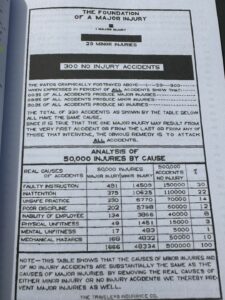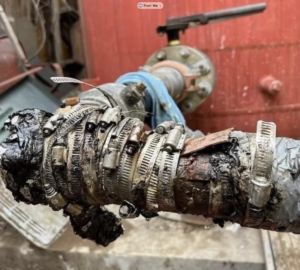Let us help you make sense of PSM / RMP!
My friend Brian Chapin will be offering an open-enrollment PSM/RMP class in Burleson, Texas, July 8th to 11th, 2025. Brian is an absolute pro in NH3 Refrigeration Process Safety. Anyone who attends will also get a FREE membership to SAFTENG. You can get more information on the class with this link.
CLICK HERE to Renew your Membership
CLICK HERE for a NEW Membership
CLICK HERE to see eligibility requirements for FREE Membership
If you have any questions, please contact m
SAFTENG has:
- Over 18,000 categorized unsafe acts/conditions and accident/injury photos
- Over 1,500 ppt's & doc's in the SAFTENG Library
- Over 4,000 Technical Articles on Process Safety, Emergency Response & OSH topics
- Over 450 videos (those not allowed on YouTube Channel)
Many THANKS to my NEW Members and those who CONTINUE to support SAFTENG:














May 29, 2024
#1
If an employee presents a work status that indicates they are able to perform restricted work or light duty work yet we do not have work available that meets the restrictions, should we enter the number of days under “On Job Transfer or Restriction” or “Away from Work?”
…
HomeRead More »
Read More
May 28, 2024
Respondent operates a facility that produces glass-to-metal seals and high-temperature co-fired ceramics for use in semiconductor products. The Facility is located just over half a mile from a residential neighborhood; just under three-quarters of a mile from a charter school; just over three-quarters of a mile from a church and a skating rink; less than one mile from an elementary school and a fire...
Read More
May 26, 2024
I am just getting into Carsten Busch’s book The Heinrich Project III and it has already made it onto my top 10 list for safety pros. Carsten put together all of H.W. Heinrich’s articles and speeches from when he was with Traveler’s Insurance. If you are a believer, as I am, in many of the traditional OSH approaches to preventing accidents, you will be amazed at Heinrich’s ability to be the safety pioneer...
Read More
May 24, 2024
There has been a lot of public debate about OSHA’s attempt to update its emergency response standards. And in this debate there has been a lot of misinformation shared across municipal and private fire brigade groups in what OSHA is actually trying to implement. This document, from OSHA, is a compilation of the questions posed and issues raised in the Notice of Proposed Rulemaking...
Read More
May 23, 2024
Respondent operates a facility to manufacture chlorine, bleach, and hydrochloric acid. At all times relevant to this CAFO, Respondent produced, used, or stored more than 2,500 pounds of chlorine at the Facility and was subject to the requirements of CAA § 112(r)(7). At all times relevant to this CAFO, Respondent produced, used, or stored hydrogen at the Facility and was subject to the requirements...
Read More
May 23, 2024
Recently, I had the pleasure of working with one of my international clients at several locations. This is in thanks to Paul A. for putting his trust in me throughout my career. Paul and I met in Omaha, NE, in the late 90s and formed a professional and personal friendship as he is ALL ABOUT SAFETY guiding business decisions. We worked for a man I have mentioned numerous times, Dale...
Read More
May 23, 2024
Much of my work involves helping clients achieve more than “compliance” with minimum government standards. I typically do this using RAGAGEPs; however, those may be too much to handle in some situations. So, I will propose another government standard that applies to the process/hazard. For example, unloading flammable liquid railcars. Canada has some of the most...
Read More
May 17, 2024
This is safety satire on a Friday afternoon after a long week! I may not be a Certified Welding Inspector (CWI) or a Visual Level II inspector certified per ASME V Supplemental NDE Certification requirements. Still, I believe API 570, Section 8 Repairs, Alterations, and Rerating of Piping Systems allows only a dozen or fewer radiator hose clamps in repair specifications. I may be slightly off,...
Read More
May 17, 2024
From OSHA’s summary of the Final Rule: Heating, Air-conditioning, & Refrigeration Distributors International (HARDI) asked OSHA to update its Process Safety Management standard (PSM), 29 CFR 1910.119, to reflect this change once this rule is finalized (Document ID 0355, p. 2). HARDI’s comment is out of scope for this rulemaking, which pertains solely to updating the HCS. However, OSHA...
Read More
May 17, 2024
OSHA is amending the Hazard Communication Standard (HCS) to conform to the United Nations’ Globally Harmonized System of Classification and Labelling of Chemicals (GHS), primarily Revision 7 (Rev. 7), address issues that arose during the implementation of the 2012 update to the HCS, and provide better alignment with other U.S. agencies and international trading partners, while enhancing the effectiveness...
Read More
May 14, 2024
I have spent much time with clients doing “Engineering and Code Reviews.” These have been instrumental in avoiding many issues when it comes time for the INITIAL PHA. Depending on the process size and complexity, these can take 0.5 – 3 days, but that time is spent ensuring the primary containment systems and all the layers of protection that come into play for the PREVENTION-PROTECTION-MITIGATION...
Read More
May 14, 2024
It is rare; I can not recall ever disputing NFPA in any of their guides/standards/codes. However, section 27.7 of NFPA 30 is worded incorrectly and needs to be called out as it poses significant risks if followed by the letter. Section 27.7 covers the pressure and leak testing of “flammable liquid” piping circuits. Although I am thankful for NFPA including this in NFPA...
Read More

















